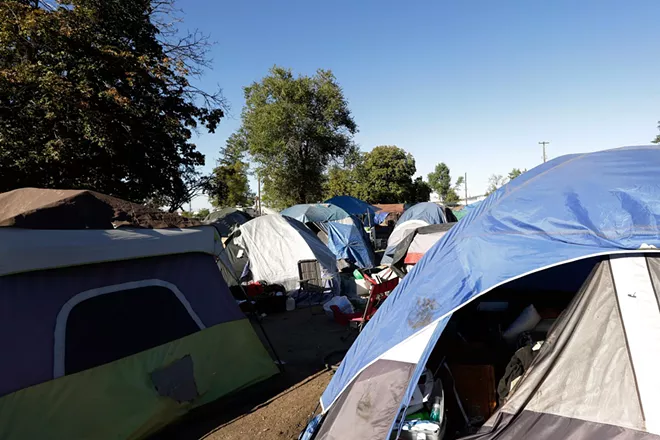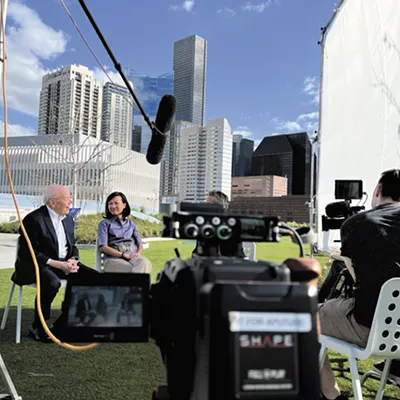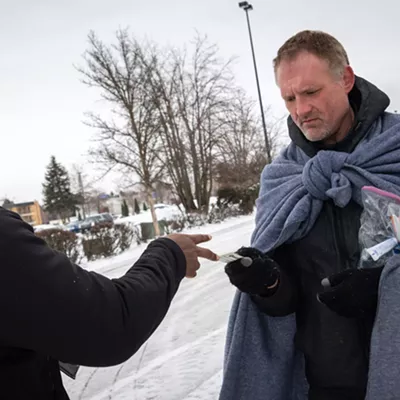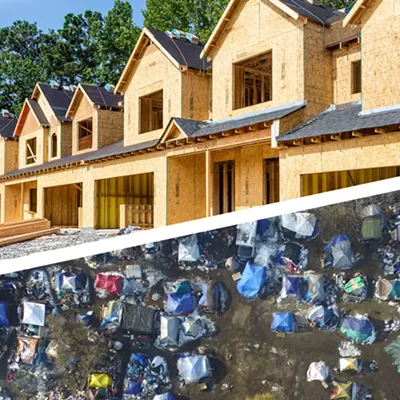In our last column on this subject ("Homelessness is Spokane's Biggest Challenge," July 21, 2022), we laid out some food for thought on a more collaborative and nonpolitical approach to addressing our community's homelessness challenges. We promised a follow-up column that would delve further into that model.
The beauty of writing an opinion column is that you get to armchair quarterback without ever having to take a live snap. Or so we thought. But somehow we have managed to not only get ourselves onto the field, but with the ball in our hands and the clock ticking.
The two of us city retirees, along with our also retired colleague Theresa Sanders, have been invited to help coordinate 90 days of community outreach and planning that we hope will result in the creation of an independent regional homelessness authority by early May. This authority would be charged with integrating the region's future strategies, funding, services and staffing to address the impacts of homelessness in our region. Not a small task, but we are thankful to the political leadership for allowing us to play this role as a part of their commitment to improve the homeless response system in our community.
So this second column and future ones will not come from the outside looking in, but from the inside looking out. We will try to use these columns to be as transparent and informative as possible as the 90-day due diligence period unfolds.
WHY A REGIONAL AUTHORITY?
The idea of a permanent, independent regional authority to better manage homelessness is not new, but its time seems ripe as community support grows for a body that could build on the immense amount of work already being done. Our elected leaders, service providers and the business community are stepping up and working closely to help us explore this opportunity more closely. And in many instances, the strongest support is coming from the very people and organizations who have already been working for many years with immense dedication and professionalism to support our homeless and vulnerable populations.
Taking a regional, collaborative approach has already had resounding and long-term success in Houston and Atlanta. And many more regions are considering doing the same, including Seattle, which has also recently adopted a regional partnership to address homelessness. These cities offer tremendous opportunities to examine their successes — and problems — and learn from their experiences as we consider our own regional, collaborative approach.
But at the heart of our optimism is the great track record of our own community in bringing collaborative approaches to address past problems and opportunities. In our first column ("Time and Again, Public Partnerships Have Transformed Spokane," June 9, 2022), we noted the impressive list of major initiatives (from Expo '74 to Kendall Yards to the West Plains Public Development Authority) that resulted from innovative public-private collaboration in our region.
When we move past our divisions, work through our differences and knock down our silos, we do really big things in this community.
HOW WOULD IT WORK?
To a great extent, answering this question is the purpose of the 90-day due diligence period we mentioned above. This process needs to include key community leaders, legislators and providers along with the community at large.
Key principles of a regional authority would include: Aligning the region to work from one playbook; depoliticizing the strategies and funding decisions; consolidating oversight and management of all resources and activities; and bringing alignment and leveraging investments in the areas of health and services, public housing and public safety.
But once again, we don't have to invent a model that we haven't already tested in our community. We have a number of regional authorities that are public corporations. Some examples are our transit system (STA), our sports, recreation and conference activities and facilities (PFD), our regional airport (SIA), and our regional health department (SRHD).
In several of these examples, municipal government (city or county) started out taking the lead, but then realized that the required focus, expertise and band-width needed was going to be beyond what a city or county government could individually provide.
The core services of city and county government include building and maintaining community infrastructure like streets, utilities, parks and libraries. Those core services also include providing community public safety like police, fire and criminal justice systems.
Cities and counties have been providing these core services since their inceptions, and the majority of their organizational structures, planning and budgets are built around these critical community services. Trying to absorb a major regional socio-economic initiative like homelessness into a single city or county government would be like trying to run regional transit or a regional airport along with all those core responsibilities. It could be overwhelming.
While a homelessness authority is more about driving regional collaboration among all the necessary public and private entities than the centralized control of these other public corporation examples, the benefits of a regional and fundamentally collaborative approach are compelling.
We fully believe we are at the point that an independent regional integrated homelessness entity is the best alternative for managing this complex issue for the long-term. And given our track record of community success stories when we acknowledge this, we have some very good collaborative regional examples to draw on.
We mentioned above that other cities are taking the regional approach. So we also will look at the Houston regional model, which involves the creation of a separate nonprofit entity, and the Seattle regional model, which was created through partnership agreements. Whatever form this may take, however, will need to be customized and unique to our regional needs and expectations.
WHAT COMES NEXT?
We are energized by the support we are hearing from so many segments of our community. Public, private and nonprofit leaders are already bringing great support and input and are leaning in to help launch this 90-day due diligence initiative in a big and positive way.
A kickoff event is planned for Feb. 10 at a location to be announced, and a game-plan for the 90-day planning, structure and goals will be outlined immediately following. ♦
Gavin Cooley was the city of Spokane's chief financial officer for 17 years, serving five different mayors, starting with Jim West. He currently is working with the city on projects including investments and the Spokane River Trail System. Rick Romero is the former utilities director and director of strategic planning for the city of Spokane. He worked on a variety of projects, including the renovation of Riverfront Park, the Podium and the downtown Spokane football stadium.





















